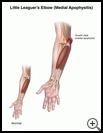
Little Leaguer's Elbow (Medial Apophysitis)
________________________________________________________________________
KEY POINTS
- Little Leaguer's elbow is an injury to the upper arm bone at the elbow, usually caused by too much pitching or throwing.
- The most important treatment is resting the arm for 1 to 3 months. During this time your healthcare provider may recommend stretching and strengthening exercises and other types of physical therapy to help your child heal.
- Treatment may include medicine, an elbow brace, ice, or sometimes surgery.
________________________________________________________________________
What is Little Leaguer's elbow?
Little Leaguer's elbow is an injury to the upper arm bone at the elbow. It happens to young athletes who are still growing.
This problem is also called medial apophysitis.
What is the cause?
Little Leaguer's elbow is caused by overuse of the arm, usually from too much pitching or throwing. The bones of young children are still growing. Repeated throwing causes wear and tear on the new, weaker bone in the elbow. In severe cases, the growing bone may actually break away from the rest of the upper arm.
Children who play baseball year-round are more likely to have overuse injuries.
What are the symptoms?
The main symptom is pain at the inner side of the elbow. Your child may have swelling and the elbow may be tender to touch.
How is it diagnosed?
Your child’s healthcare provider will ask about your child’s symptoms, medical history, and activities and examine your child's arm. Tests may include X-rays or other scans.
How is it treated?
The most important treatment is resting of the arm. Depending on how severe the injury is, your child may need to stop throwing for 1 to 3 months, limit the number of throws, or limit how much he plays. During this time your healthcare provider may recommend stretching and strengthening exercises and other types of physical therapy to help your child heal.
If there is a break in the bone, your child may need surgery.
The pain often gets better within a few weeks with self-care, but some injuries may take several months or longer to heal. It’s important to follow all of your healthcare provider’s instructions.
How can I help take care of my child?
Follow the full course of treatment your child’s healthcare provider prescribes.
To keep swelling down and help relieve pain:
- Put an ice pack, gel pack, or package of frozen vegetables wrapped in a cloth on the injured area every 3 to 4 hours for up to 20 minutes at a time for the first day or two after the injury.
- Give your child nonprescription pain medicine, such as acetaminophen, ibuprofen, or naproxen. Read the label carefully and give your child the correct dose as directed.
- Nonsteroidal anti-inflammatory medicines (NSAIDs), such as ibuprofen and naproxen, may cause stomach bleeding and other problems. Read the label and take as directed. Unless recommended by your healthcare provider, your child should not take the medicine for more than 10 days.
- Check with your healthcare provider before you give any medicine that contains aspirin or salicylates to a child or teen. This includes medicines like baby aspirin, some cold medicines, and Pepto-Bismol. Children and teens who take aspirin are at risk for a serious illness called Reye's syndrome.
- Use an elastic elbow wrap to give the elbow more support.
Follow your healthcare provider's instructions, including any exercises recommended by your provider. Ask your child’s healthcare provider:
- How and when you will get your child’s test results
- How long it will take for your child to recover
- If there are activities your child should avoid and when your child can return to normal activities
- How to take care of your child at home
- What symptoms or problems you should watch for and what to do if your child has them
Make sure you know when your child should come back for a checkup.
How can I help prevent Little Leaguer's elbow?
The best way to prevent Little Leaguer's elbow is to limit how much your child throws. If your child is a baseball pitcher, be sure to follow the guidelines for how many pitches or innings a child can throw in a week. In general:
- A child 9 through 12 years old should pitch no more than 6 innings a week and should throw no more than 250 pitches.
- A child 13 through 15 years old should pitch no more than 9 innings a week and should throw no more than 350 pitches.
It’s best if your child rests for a day after pitching a game. When your child is not pitching, he or she needs to be sure they are not throwing hard while playing another position (like shortstop), practicing, or playing other sports. It’s also very important for your child to learn proper pitching technique.
Children should not play through pain. If your child’s arm hurts, your child should stop throwing.
Last modified: 2017-03-01
Last reviewed: 2017-03-01

